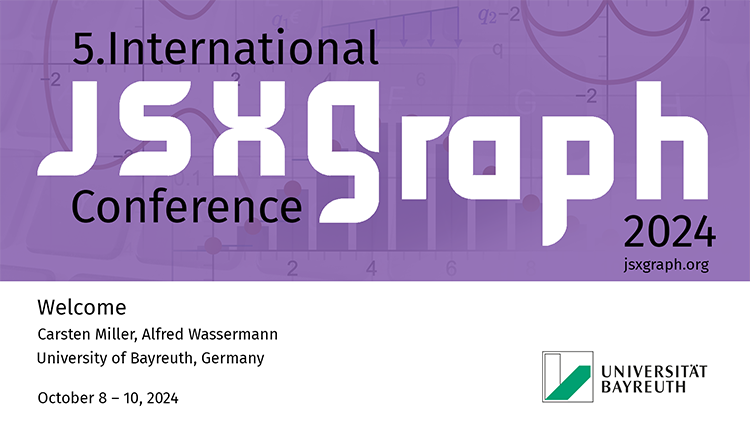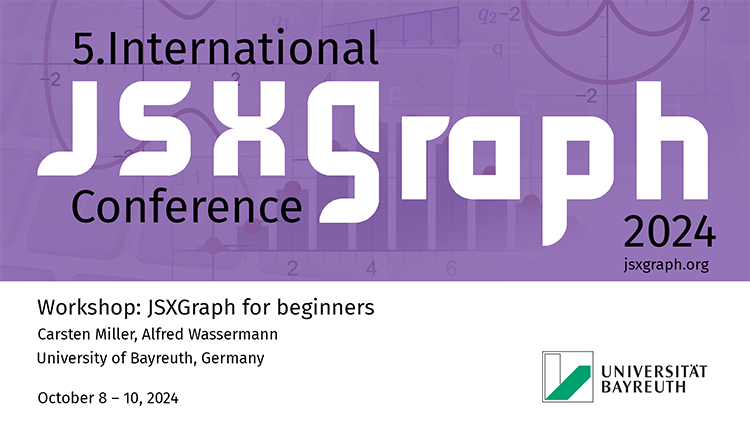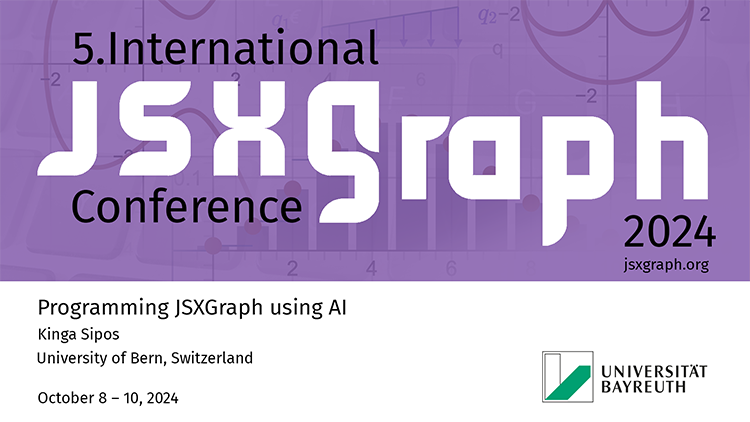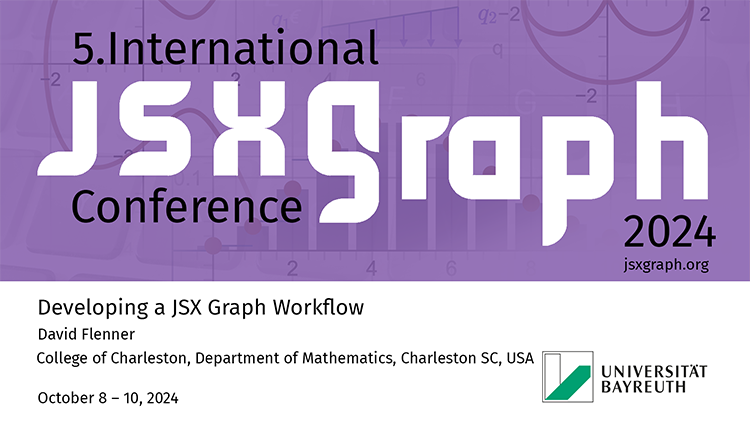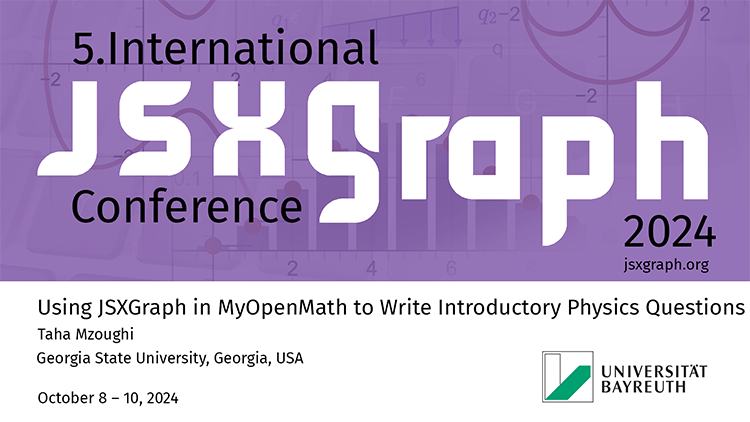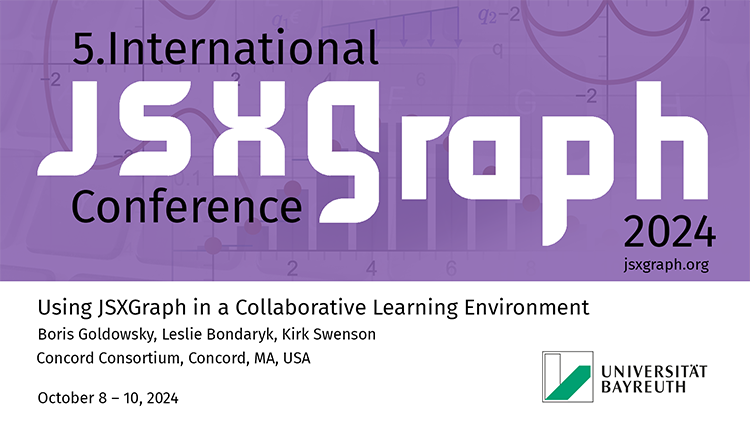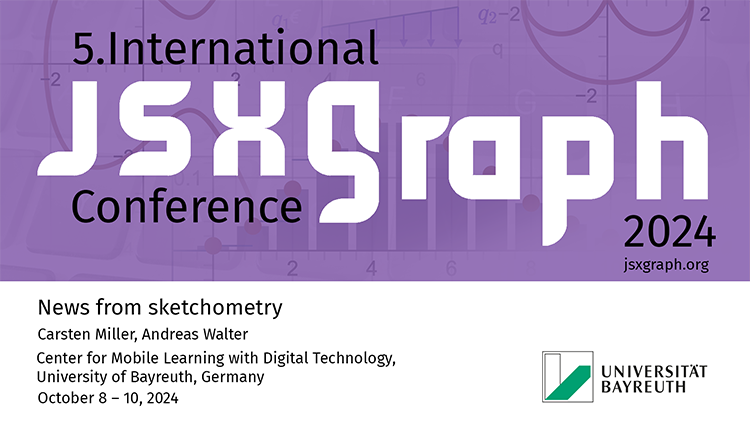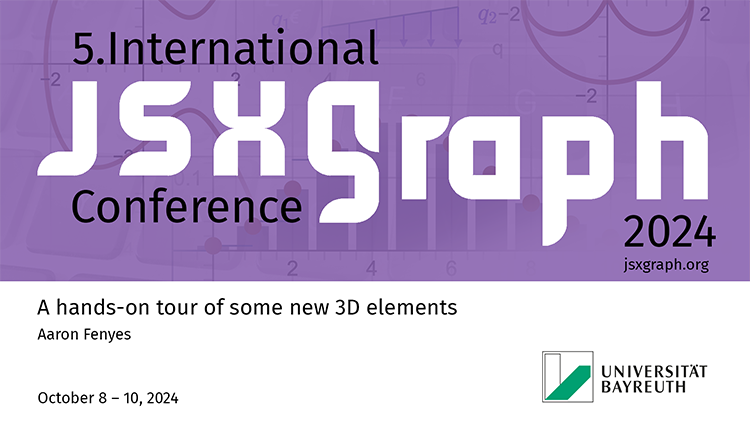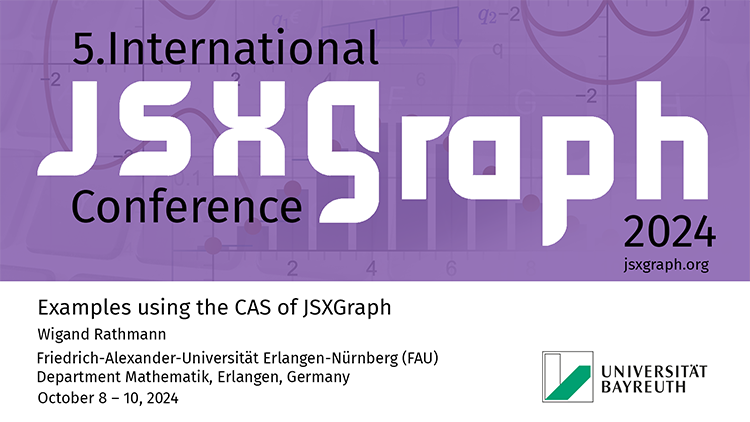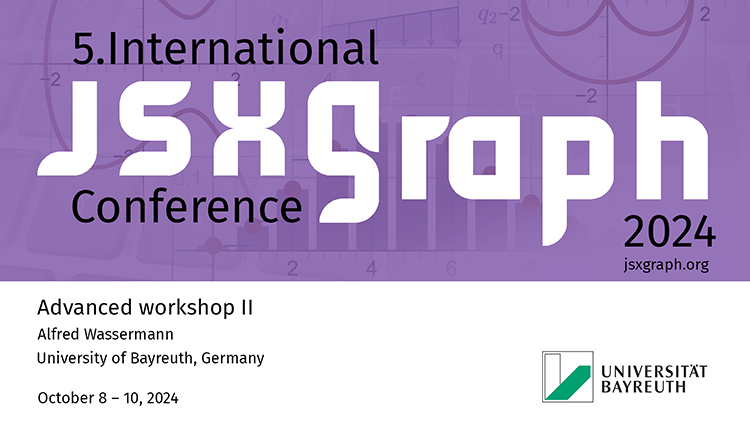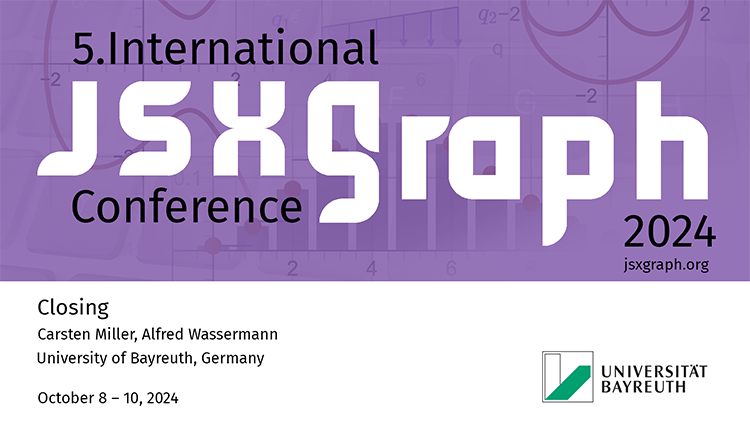Program
Last update 04.10.2024, 09:00 am
Timezone
All times are in CEST (UTC+2).
Day one, October 8th, 2024
- 15:00: Welcome
- 15:10: Carsten Miller, Alfred Wassermann: Workshop: JSXGraph for beginners , PDF notes
- 16:15: Break
- 16:45: Kinga Sipos: Programming JSXGraph using AI
- 17:15: David Flenner: Developing a JSX Graph Workflow
Day two, October 9th, 2024
- 14:50: Meet & Greet
- 15:00: Taha Mzoughi: Using JSXGraph in MyOpenMath to Write Introductory Physics Questions
- 15:30: Boris Goldowsky, Leslie Bondaryk, Kirk Swenson: Using JSXGraph in a Collaborative Learning Environment
- 16:00: Break
- 16:15: Carsten Miller, Andreas Walter: News from sketchometry
- 16:45: Alfred Wassermann: Advanced workshop I + discussion, PDF notes for workshop parts I + II
Day three, October 10th, 2024
- 14:50: Meet & Greet
- 15:00: Andreas Maurischat: JSXGraph 3D in MUMIE
- 15:30: Aaron Fenyes: Workshop: A hands-on tour of some new 3D elements
- 16:15: Break
- 16:45: Wigand Rathmann: Examples using the CAS of JSXGraph
- 17:15: Alfred Wassermann: Advanced workshop II , PDF notes for workshop parts I + II
- 18:00: Closing
Program
Advanced workshop I, II
Alfred Wassermann
University of Bayreuth, Germany
alfred.wassermann@uni-bayreuth.de Abstract In two workshops we will cover more advanced topics of JSXGraph programming. The topics will mostly be oriented on changes that happened in JSXGraph since the last conference, that is since version v1.6.2. The plan so far is to cover:
Progress in 3D Using implicit curve plotting Update on available statistical methods Label positioning for lines, circles and curves Showcase the recent overhaul of elements “grid” and “axis” Examples for working with complex numbers
Program
Examples using the CAS of JSXGraph
Wigand Rathmann
Friedrich-Alexander-Universität Erlangen-Nürnberg (FAU), Department Mathematik, Erlangen, Germany
wigand.rathmann@fau.de Abstract I use JSXGraph a lot in my engineering mathematics classes. I can set up a board for special purposes, perhaps by using a CAS like Maxima. This often follows the typical cycle of developing and debugging a JSXGraph applet:
🤔😕😫🤔😡😮🤦♂️😊😅😎 Thanks to getDigital When an applet works as expected, you are usually very happy. At this point the loop of improvements and the search for tools to realize the ideas (and the development and debugging phases) starts.
Program
A hands-on tour of some new 3D elements
Aaron Fenyes
aaron.fenyes@fareycircles.ooo Abstract Over the summer, JSXGraph gained some new 3D elements and capabilities. This short workshop will help you start using them in your constructions. After seeing examples of the new features in action, you’ll have time to explore them yourself by building on JavaScript templates that I’ll provide.
The new 3D elements include spheres, circles, polygons, and a few gliders and intersections. The new capabilities include “virtual trackball” navigation and depth-ordering for points.
Program
Developing a JSX Graph Workflow
David Flenner
College of Charleston, Department of Mathematics, Charleston SC, USA
flennerdr@cofc.edu Abstract I have been developing with JSX Graph since 2017 when I started making interactive visualizations for an online Trigonometry class I was creating at the time. Since then, I have created over a hundred online applications that I use in my teaching daily, and all hosted on GitHub so that anyone who would like to learn the mathematics from them - or how they are programmed - are freely able to.
Program
JSXGraph 3D in MUMIE
Andreas Maurischat
integral-learning, Germany
andreas.maurischat@integral-learning.de Abstract In a joint project with RWTH Aachen University, we incorporated the usage of JSXGraph 3D in our MUMIE framework. This new development inherits the usual features that MUMIE supports: Easy programming for lecturers in LaTeX-style code; automatic interaction among canvases and between canvases and text; usage as graphical exercises.
In this talk, we present some examples from several variable calculus.
Program
News from sketchometry
Carsten Miller, Andreas Walter
Center for Mobile Learning with Digital Technology, University of Bayreuth, Germany
carsten.miller@uni-bayreuth.de , andreas.walter@uni-bayreuth.de Abstract sketchometry - in touch with geometry!
At the Center for Mobile Learning with Digital Technology we are not only developing the JavaScript library JSXGraph, but also the gesture-based geometry software sketchometry.
You draw with your finger on your smartphone or tablet. sketchometry converts your sketches into precise geometric constructions that you can modify and move.
Program
Programming JSXGraph using AI
Kinga Sipos
University of Bern, Switzerland
kinga.sipos@unibe.ch Abstract Visualisations play a crucial role in education, particularly in mathematics, by aiding the understanding of complex concepts. Static visualisations help structure and represent knowledge in more concentrated, often simplified ways that cater to different learning styles. Meanwhile, interactive graphs offer students the chance to explore concepts independently, fostering deeper intuition and increasing engagement with the learning material.
In this presentation, I will share my experience using JSXGraph integrated into the ILIAS plugin for STACK, exploring its potential for creating interactive educational tools.
Program
Using JSXGraph in a Collaborative Learning Environment
Boris Goldowsky, Leslie Bondaryk, Kirk Swenson
Concord Consortium, Concord, MA, USA
lbondaryk@concord.org Abstract Concord Consortium’s Collaborative Learning User Environment (CLUE) is a web-based application that allows students to share mathematics work in small groups or across the class either in person or asynchronously. CLUE documents can contain multiple types of “tiles”, including text, images, tables, and graphs. JSXGraph underlies the implementation of CLUE’s Coordinate Grid tile. This environment is used in research programs to study student acquisition of math concepts.
Program
Using JSXGraph in MyOpenMath to Write Introductory Physics Questions
Taha Mzoughi
Georgia State University, Georgia, USA
tmzoughi@gsu.edu Abstract I will give a talk about the use of JSXGraph to develop new introductory physics questions. These questions were developed using MyOpenMath, an online course management and assessment system for mathematics and other quantitative disciplines. MyOpenMath is a nonprofit organization made up of a collaborative community of educators focused on providing algorithmically generated assessment to support the use of free, open textbooks.
Program
Workshop: JSXGraph for beginners
Carsten Miller, Alfred Wassermann
University of Bayreuth, Germany
carsten.miller@uni-bayreuth.de , alfred.wassermann@uni-bayreuth.de Abstract This workshop will cover the basics of working with JSXGraph. The nice thing about the JSXGraph is that you do not need to be a programmer to use it. In the workshop, we will talk about the tools and how to prepare the working environment. By constructing the examples, we will cover some basic objects as points, lines, circles, intersections, and angles.
